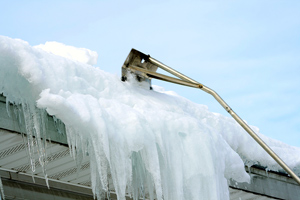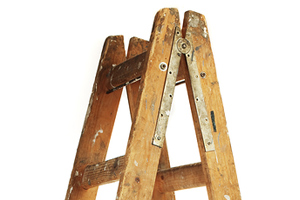Quality matters when hiring for a big project. Call a Best Pick now!
Being snowed in for a day or so can be fun—with the proper supplies on hand, of course—but it doesn’t take long for the reality of the situation to set in. Just like any other type of extreme weather, snow can do a lot of damage. Large amounts of accumulated snow can cause ice dams and serious structural problems. Before you bundle up and go outside, however, keep reading for our roof snow removal tips.
How Do You Remove Snow From Your Roof?
Your roof is designed to withstand plenty of severe weather, but it isn’t completely immune to damage. Using the wrong tool or using the right tool improperly can damage shingles, opening up your roof to a host of other problems.
1. Remove Icicles
Start by knocking loose any icicles on your roof edge. While they look pretty, they can fall and injure you. Use a long-handled broom or another long tool and stand back so they fall away from you.
2. Clear the Snow with a Roof Rake

Next, clear the snow with a roof rake. Rook rakes, also called snow rakes, are long shovel-like tools that allow you to pull snow off your roof from the ground. Use a roof rake with small wheels or a bumper to keep it from scraping the shingles.
Work from the roof overhangs up toward the peak of the roof, clearing about a foot of snow at a time. If you try to clear too much in one pass, you’ll risk packing the snow, which makes it heavier and more difficult to remove.
While it may seem counterintuitive, try to leave a few inches of snow behind. This will prevent thermal shock that can lead to ice dams. It also prevents the rake from damaging the surface of your roof.
Do not use a metal shovel or rake to remove snow from your roof. You can damage your roof and lead to more problems like water leaks.
3. Watch Where You Rake the Snow
While the goal is to get heavy snowfall off your roof, you don’t want to cause other problems. Leaving too much snow piled up around your foundation can lead to leaks when it melts.
Try to direct all the snow to your driveway, so you can shovel it away from your home. Otherwise, come back with a shovel and remove some of the fallen snow.
4. Leave the Ladder in the Garage.

The most important tip is to stay off the roof. While you might think using a ladder or even climbing on the roof will make removing the snow easier, it’s actually extremely dangerous. Not only can you fall off the roof, but you could even fall through it. If you don’t have a roof rake, it’s best to leave snow cleanup to the roofing professionals.
When Do You Need To Remove Snow From Your Roof?
Before you decide how to remove snow from your roof, determine whether you need to do anything. Most roofs will withstand a significant amount of weight from snow. It is unlikely that an average—or even a little above average—snowfall will cause your roof to collapse.
While a lot of snow on your roof might be concerning, it all comes down to weight distribution. Dry, powdery snow weighs far less than heavy, wet snow. Watch your local forecast to get details about expected snowfall amounts and what kind of snow you might encounter.
When in doubt, pick up a shovelful or two from the ground—the kind of snow you’re dealing with will be quickly apparent.
Tips for Staying Safe When Cleaning Snow Off of Your Roof
- Wear heavy, slip-proof winter boots
- Dress for the weather
- Remove icicles first
- Do not use a ladder or get up on your roof
- Work in sections and take breaks
- Leave some snow on the roof
In most cases, snow on your roof isn’t a crisis, but it is a good idea to try to keep accumulation to a minimum. Remove what you can with a roof snow rake. Focus your efforts on the roof’s overhangs—also called eaves—to lessen the risk of ice dams forming. If your roof is too high or too intricate to rake from the ground, don’t try to take on the job yourself. Professionals have the proper tools and safety equipment to clear a snow-covered roof safely and quickly.


























